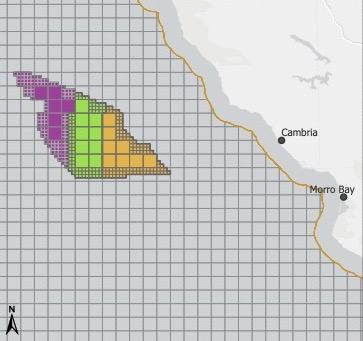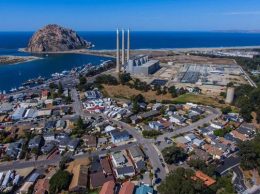Lease auction set for Morro Bay wind farm
IN THIS ARTICLE
- Energy Topic
- Jorge Mercado Author
By Jorge Mercado Thursday, October 20th, 2022
In a little more than six weeks, more than 40 companies will bid on the first-ever offshore wind lease sale on the West Coast, competing for the right to build floating offshore wind farms off the coast of Morro Bay and elsewhere.
The U.S. Department of the Interior announced Oct. 18 that the Bureau of Ocean Energy Management will hold an offshore wind energy lease sale on Dec. 6 for areas off Central and Northern California. The auction will cover about 373,000 acres off of the coast of Humboldt County in Northern California and Morro Bay on the Central Coast.
The Bureau of Ocean Energy Management projects the sale has the potential to produce over 4.5 gigawatts of offshore wind energy, enough to power more than 1.5 million homes, and will support thousands of new jobs.
“This has been a long time coming. Years of discussion is now culminating into this final sale notice,” Josh Boswell, the vice president of policy and economic development at REACH — the San Luis Obispo-based Regional Economic Action Coalition — told the Business Times. “There’s a lot of work to be done to actually make this happen and translate this into meaningful economic opportunity to advance our climate goals, but I think it’s clearly a huge milestone. Floating offshore wind has not been done at scale anywhere in this country and so this is really a first for the nation.”
The final sale notice outlines that 43 companies are qualified to bid in the offshore wind energy lease auction, up from 23 companies that expressed interest in May, when the BOEM announced the proposed sale notice.
All 43 companies, which include oil and gas subsidiaries as well as renewable-only companies, will have to submit a bidder’s financial form to the BOEM by Nov. 4 to be considered for the auction.
BOEM has also split the 373,000-plus acres into five separate leases. Three of those leases are about 80,000 acres each located off the coast of San Luis Obispo County. The other two leases are about 20 miles offshore from Eureka, in Humboldt County.

Starting bids for any lease will begin at $100 per acre. This means at a minimum, the auction should net $37 million. Companies that win a bid will also pay $3 per acre per year for their ocean space until it begins producing electricity.
The companies will also qualify for bidding credits, which means a certain percentage of their total winning bid would be discounted. Up to 20% of the total winning bid could be discounted if the company shows an established plan for workforce development, supply chain development and other requirements.
The winning bidders will also be held to BOEM’s lease standards, which include working closely with local governments, commercial fishers, tribes and others impacted by the proposed developments to identify ways to minimize detrimental impacts.
After the auction, a company has up to one year to submit a site assessment plan outlining how to assess the lease area to build wind turbines.
Once constructed, the wind farms would be the first with floating offshore wind turbines in the United States. Floating turbines can be in deeper waters and farther from shore than in-ground turbines that are located in shallower waters along parts of the East Coast.
“Floating offshore wind will be a new technology. The benefit of doing it further out is much less of an impact visually, which has been one of the early challenges when offshore wind first came about decades ago. But also if you are further out, there’s stronger winds, there’s more space,” Boswell said. “Offshore wind is an important and reliable source of power that can and should play a larger role in the state’s energy portfolio.”
On Sept. 1, the state announced plans to extend the life of the Diablo Canyon nuclear power plant near Morro Bay until 2030, citing concern that California does not have sufficient clean power to meet the state’s energy needs.
Local politicians and organizations that supported the extension of the power plant’s life span said that continuing to invest in renewable energy sources is critical to avoid having to extend the plant again. Offshore wind can be important part of that strategy, Boswell said.
“I think there was a recognition that part of the rationale for how the state landed on that extension date of 2030 was to ensure that there is no delay for the deployment of offshore wind and similar renewable efforts,” he said.
Elected officials at the state and federal levels, in both parties, praised the upcoming auction for offshore wind leases. Assemblymember Jordan Cunningham, R-San Luis Obispo, issued a statement calling the Central Coast “the next Clean Energy Capital of the United States.”
And U.S. Rep. Salud Carbajal, D-Santa Barbara, issued a statement that said offshore wind “holds incredible promise as a means to tackle climate change, and will serve our environmental, energy, national security, and economic prosperity goals for generations to come.”










